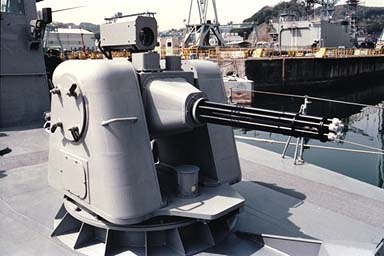|
|

Japanese 20 mm/76 Gatling Gun
|
|
|

Japanese 20 mm/76 Gatling Gun
|
| Designation | 20 mm/76 M-61A1 Gatling Mark 15 |
| Ship Class Used On | 1-GÔ (Model 1) Patrol Boats |
| Date Of Design | N/A |
| Date In Service | about 1990 |
| Gun Weight | N/A |
| Gun Length | N/A |
| Bore Length | about 59.8 in (1.520 m) |
| Rifling Length | N/A |
| Grooves | N/A |
| Lands | N/A |
| Twist | N/A |
| Chamber Volume | N/A |
| Rate Of Fire | 3,000 rounds per minute cyclic |
| Type | Fixed |
| Projectile Types and Weights | APDS Mark 149 - 0.22 lbs. (0.10 kg)
APDS Mark149-2 - 0.22 lbs. (0.10 kg) APDS Mark 149-4 - 0.22 lbs. (0.10 kg) |
| Bursting Charge | N/A (Solid Shot) |
| Projectile Length | 6.62 in (16.8 cm) |
| Propellant Charge | N/A |
| Cartridge | 20 x 102 mm |
| Muzzle Velocity | 3,650 fps (1,113 mps) |
| Working Pressure | N/A |
| Approximate Barrel Life | N/A |
| Ammunition stowage per gun | N/A |
| Notes:
1) The sub-caliber penetrator of the Mark 149 is 0.502 inches (12.75 mm) in diameter. 2) The Mark 149 projectile was developed to provide a significantly increased anti-armor capability, optimized exterior ballistic performance and short time-of-flight over the previous Mark 50 round. The original Mark 149-2 projectile was a depleted-uranium sub-caliber penetrator. In 1988, the US Navy switched to the Mark 149-4 which uses a tungsten penetrator. The change over to tungsten was in order to reduce radiation exposure to personnel and to lessen the environmental impact. Tests with the tungsten penetrator showed acceptable results against likely missile and aircraft threats. The Mark 149-4 round includes a red tracer. |
|
| Elevation | With 0.22 lbs. (0.11 kg) APDS Shell |
| Range @ 45 degrees | 6,000 yards (5,500 m) |
| Maximum effective range | 1,625 yards (1,490 m) |
| Designation | N/A |
| Weight | N/A |
| Elevation | -20 / +80 degrees |
| Rate of Elevation | N/A |
| Train | 360 degrees |
| Rate of Train | N/A |
| Gun Recoil | N/A |
22 February 2006 - Benchmark
27 May 2012 - Updated to latest template